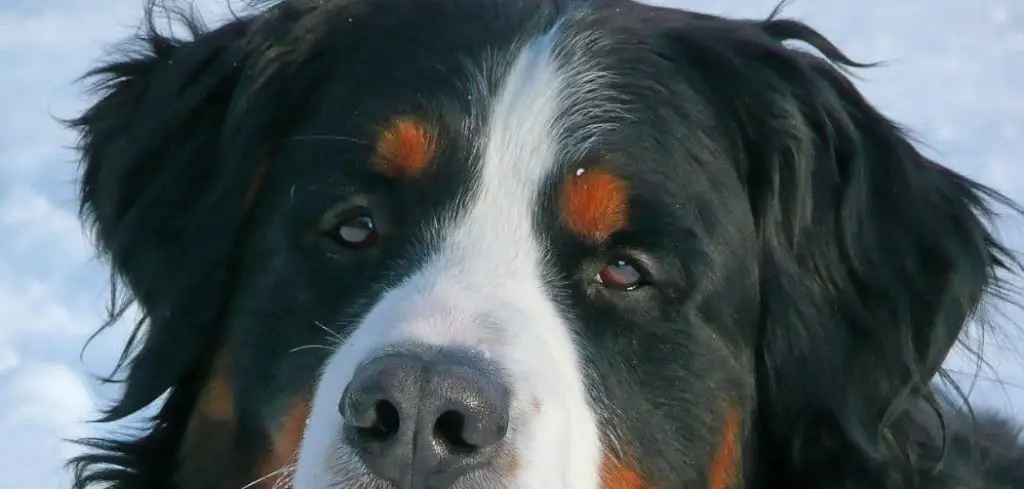Dogs pant for many normal reasons, but when panting is paired with noticeably large pupils, it can point to something more serious. These symptoms may signal stress or underlying health issues.
We outline the common reasons why a dog panting with big pupils happens, what you can do at home, and when to seek veterinary help.
Table of Contents
Dog Panting and Big Pupils — Why It Happens
A dog panting with dilated pupils is often linked to your dog’s nervous system reacting to stress, pain, or changes in their body. It can occur due to anxiety, overheating, poisoning, injury, or medical conditions affecting the heart, brain, or eyes.
Because these signs can develop suddenly or worsen quickly, they should be taken seriously and evaluated to prevent complications.

Dog Panting and Big Pupils: Common Causes
Anxiety or Fear
When dogs feel stressed or frightened, their bodies release adrenaline. This hormone increases heart rate, speeds breathing, and dilates pupils to take in more visual information.
You might notice this if your dog is in a new environment, hears loud noises, or faces a situation they find threatening.
While short-term episodes often resolve on their own, frequent anxiety can harm your dog’s well-being.
Read more: Dog Panting and Bobbing Head (Here’s why)
Pain
Pain triggers both panting and pupil dilation as part of the body’s stress response. This can happen with injuries, arthritis flare-ups, dental issues, or internal problems.
Dogs in pain may also become restless, hide, or show sensitivity when touched. Because pain can worsen without treatment, finding the cause quickly is essential.
Heatstroke
Overheating is a dangerous cause of panting and big pupils. Dogs can’t sweat effectively, so they rely on panting to cool down.
In heatstroke, their body temperature rises too high, causing distress and dilated pupils.
This condition can progress rapidly to collapse or even death, so prompt cooling and veterinary care are crucial.
Toxin Exposure
Some toxins, such as certain plants, medications, or chemicals, can overstimulate a dog’s nervous system. This can lead to rapid breathing, tremors, vomiting, and dilated pupils.
Poisoning is always a medical emergency. The sooner your dog gets treatment, the better their chances of recovery.
Eye Injury or Disease
Eye problems like glaucoma or trauma can directly cause pupils to dilate. Panting may occur alongside due to discomfort or pain.
You may also see redness, cloudiness, or your dog rubbing at their face. Eye conditions often require prompt veterinary care to prevent vision loss.
Neurological Issues
Problems affecting the brain, such as seizures, head trauma, or certain infections, can result in both panting and dilated pupils. These changes can be sudden and severe.
Because neurological issues can be life-threatening, emergency veterinary evaluation is necessary if symptoms arise.
What to Do If Your Dog Is Panting and Has Big Pupils
Stay calm so your dog doesn’t pick up on your stress. Move them to a quiet, safe environment away from loud noises, heat, or other triggers.
Check for other symptoms such as vomiting, limping, disorientation, or changes in breathing. If they are overheating, help cool them with damp towels and ensure they have fresh water.
If you suspect toxin exposure or injury, do not wait to see if symptoms improve. Immediate veterinary advice is the safest step.
Keep your dog comfortable and monitor their behavior closely until you can get professional help.
When to Call or Visit Your Vet
If your dog’s panting and dilated pupils appear suddenly, worsen, or come with other alarming signs, seek veterinary care right away.
Watch for difficulty breathing, collapse, persistent vomiting, vision changes, or signs of extreme pain. These could indicate heatstroke, poisoning, or neurological emergencies.
Even if your dog seems to recover, unexplained pupil changes can reveal hidden medical problems, so a prompt check-up is wise.
Read more: Dog panting excessively (Here’s why)
Key Takeaway
Panting with big pupils in dogs can be triggered by something as mild as momentary fear or as serious as heatstroke or poisoning.
Because the causes range from minor to life-threatening, monitoring your dog closely and contacting your vet when symptoms are severe or persistent is the safest course.
Trust your instincts—you know your dog best. Quick action can make a big difference in protecting their health and comfort.
